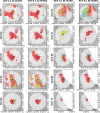Climate predictors and climate change projections for avian haemosporidian prevalence in Mexico
- PMID: 35535473
- PMCID: PMC11010484
- DOI: 10.1017/S0031182022000683
Climate predictors and climate change projections for avian haemosporidian prevalence in Mexico
Abstract
Long-term, inter-annual and seasonal variation in temperature and precipitation influence the distribution and prevalence of intraerythrocytic haemosporidian parasites. We characterized the climatic niche behind the prevalence of the three main haemosporidian genera (Haemoproteus, Plasmodium and Leucocytozoon) in central-eastern Mexico, to understand their main climate drivers. Then, we projected the influence of climate change over prevalence distribution in the region. Using the MaxEnt modelling algorithm, we assessed the relative contribution of bioclimatic predictor variables to identify those most influential to haemosporidian prevalence in different avian communities within the region. Two contrasting climate change scenarios for 2070 were used to create distribution models to explain spatial turnover in prevalence caused by climate change. We assigned our study sites into polygonal operational climatic units (OCUs) and used the general haemosporidian prevalence for each OCU to indirectly measure environmental suitability for these parasites. A high statistical association between global prevalence and the bioclimatic variables ‘mean diurnal temperature range’ and ‘annual temperature range’ was found. Climate change projections for 2070 showed a significant modification of the current distribution of suitable climate areas for haemosporidians in the study region.
Keywords: Avian haemosporidia; avian malaria; climate change models; disease ecology; landscape parasitology.
Conflict of interest statement
None.
Figures




Similar articles
-
Prevalence and diversity of avian blood parasites in a resident northern passerine.Parasit Vectors. 2019 Jun 10;12(1):292. doi: 10.1186/s13071-019-3545-1. Parasit Vectors. 2019. PMID: 31182151 Free PMC article.
-
Factors governing the prevalence and richness of avian haemosporidian communities within and between temperate mountains.PLoS One. 2017 Sep 7;12(9):e0184587. doi: 10.1371/journal.pone.0184587. eCollection 2017. PLoS One. 2017. PMID: 28880919 Free PMC article.
-
Seasonal dynamics of haemosporidian (Apicomplexa, Haemosporida) parasites in house sparrows Passer domesticus at four European sites: comparison between lineages and the importance of screening methods.Int J Parasitol. 2020 Jun;50(6-7):523-532. doi: 10.1016/j.ijpara.2020.03.008. Epub 2020 May 16. Int J Parasitol. 2020. PMID: 32422301 Free PMC article.
-
Evolutionary ecology, taxonomy, and systematics of avian malaria and related parasites.Acta Trop. 2020 Apr;204:105364. doi: 10.1016/j.actatropica.2020.105364. Epub 2020 Jan 30. Acta Trop. 2020. PMID: 32007445 Review.
-
Exo-erythrocytic development of avian malaria and related haemosporidian parasites.Malar J. 2017 Mar 3;16(1):101. doi: 10.1186/s12936-017-1746-7. Malar J. 2017. PMID: 28253926 Free PMC article. Review.
Cited by
-
Different age, different blood parasites - Acrocephalus species and their haemosporidian parasites during autumn migration in Central Europe.Int J Parasitol Parasites Wildl. 2025 Jun 1;27:101085. doi: 10.1016/j.ijppaw.2025.101085. eCollection 2025 Aug. Int J Parasitol Parasites Wildl. 2025. PMID: 40524831 Free PMC article. Review.
-
Seasonal haemosporidian detection in mosquitoes (Diptera: Culicidae) and their interactions with vertebrate hosts in a Mexican cloud forest.Parasitol Res. 2024 Nov 13;123(11):379. doi: 10.1007/s00436-024-08387-8. Parasitol Res. 2024. PMID: 39535544
-
Predicting climate-driven distribution shifts in Hyalomma marginatum (Ixodidae).Parasitology. 2023 Sep;150(10):883-893. doi: 10.1017/S0031182023000689. Epub 2023 Jul 31. Parasitology. 2023. PMID: 37519234 Free PMC article.
References
-
- Álvarez-Mendizábal P, Villalobos F, Rodríguez-Hernández K, Hernández-Lara C, Rico-Chávez O, Suzán G, Chapa-Vargas L and Santiago-Alarcon D (2021) Metacommunity structure reveals that temperature affects the landscape compositional patterns of avian malaria and related haemosporidian parasites across elevations. Acta Oecologica 113, 10.1016/j.actao.2021.103789 - DOI
-
- Atkinson CT (1999) Chapter 24: haemosporidiosis. In Friend M and Franson JC (eds), Field Manual of Wildlife Diseases. Washington, DC: USGS Biological Resources Division, pp. 193–200.
-
- Atkinson CT, Utzurrum RB, LaPointe DA, Camp RJ, Crampton LH, Foster JT and Giambelluca TW (2014) Changing climate and the altitudinal range of avian malaria in the Hawaiian Islands – an ongoing conservation crisis on the island of Kaua'i. Global Change Biology 20, 2426–2436. - PubMed
-
- Bates D, Mächler M, Bolker BM and Walker SC (2015) Fitting linear mixed-effects models using lme4. Journal of Statistical Software 67, 1–48.
-
- Beadell JS, Gering E, Austin J, Dumbacher JP, Peirce MA, Pratt TK, Atkinson CT and Fleischer RC (2004) Prevalence and differential host-specificity of two avian blood parasite genera in the Australo-Papuan region. Molecular Ecology 13, 3829–3844. - PubMed
Publication types
MeSH terms
LinkOut - more resources
Full Text Sources

